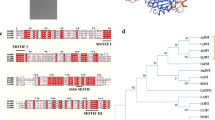Abstract
Coumarin forms in melilotoside (trans-ortho-coumaric acid glucoside)-containing plant species upon cell damage. In moldy melilotoside-containing plant material, trans-ortho-coumaric acid is converted by fungi to 4-hydroxycoumarin, two molecules of which spontaneously combine with formaldehyde to give dicoumarol. Dicoumarol causes internal bleeding in livestock and is the forerunner of the warfarin group of medicinal anticoagulants. Here, we report 4-hydroxycoumarin formation by biphenyl synthase (BIS). Two new BIS cDNAs were isolated from elicitor-treated Sorbus aucuparia cell cultures. The encoded isoenzymes preferred ortho-hydroxybenzoyl (salicoyl)-CoA as a starter substrate and catalyzed a single decarboxylative condensation with malonyl-CoA to give 4-hydroxycoumarin. When elicitor-treated S. aucuparia cell cultures were fed with the N-acetylcysteamine thioester of salicylic acid, 4-hydroxycoumarin accumulated in the culture medium. Incubation of the BIS isoenzymes with benzoyl-CoA and malonyl-CoA resulted in the formation of 3,5-dihydroxybiphenyl which is the precursor of the phytoalexins of the Maloideae.







Similar content being viewed by others
References
Abd El-Mawla AMA, Beerhues L (2002) Benzoic acid biosynthesis in cell cultures of Hypericum androsaemum. Planta 214:727–733
Abe I, Abe T, Wanibuchi K, Noguchi H (2006) Enzymatic formation of quinolone alkaloids by a plant type III polyketide synthase. Org Lett 8:6063–6065
Aliotta G, Cafiero G, De Feo V, Sacchi R (1994) Potential allelochemicals from Ruta graveolens L. and their action on radish seeds. J Chem Ecol 20:2761–2775
Appendino G, Tagliapietra S, Nano GM, Picci V (1988a) Ferprenin, a prenylated coumarin from Ferula communis. Phytochemistry 27:944–946
Appendino G, Tagliapietra S, Gariboldi P, Nano GM, Picci V (1988b) ω-Oxygenated prenylated coumarins from Ferula communis. Phytochemistry 27:3619–3624
Arnoldi L, Ballero M, Fuzzati N, Maxia A, Percalli E, Pagni L (2004) HPLC-DAD-MS identification of bioactive secondary metabolites from Ferula communis roots. Fitoterapia 75:342–354
Austin MB, Noel JP (2003) The chalcone synthase superfamily of type III polyketide synthases. Nat Prod Rep 20:79–110
Beuerle T, Pichersky E (2002) Purification and characterization of benzoate: coenzyme A ligase from Clarkia breweri. Arch Biochem Biophys 400:258–264
Bourgaud F, Hehn A, Larbat R, Doerper S, Gontier E, Kellner S, Matern U (2006) Biosynthesis of coumarins in plants: a major pathway still to be unravelled for cytochrome P450 enzymes. Phytochem Rev 5:293–308
Brown SA (1986) Biochemistry of plant coumarins. In: Conn EE (ed) Recent advances in phytochemistry, vol 20: the shikimic acid pathway. Plenum Press, New York, pp 287–316
Bye A, King HK (1970) The biosynthesis of 4-hydroxycoumarin and dicoumarol by Aspergillus fumigatus Fresenius. Biochem J 117:237–245
Chexal KK, Fouweather C, Holker JS (1975) The biosynthesis of fungal metabolites. Part VII. Production and biosynthesis of 4,7-dimethoxy-5-methylcoumarin in Aspergillus variecolor. J Chem Soc (Perkin 1):554–556
Ferrer JL, Jez JM, Bowman ME, Dixon RA, Noel JP (1999) Structure of chalcone synthase and the molecular basis of plant polyketide biosynthesis. Nat Struct Biol 6:775–784
Gaid MM, Sircar D, Beuerle T, Mitra A, Beerhues L (2009) Benzaldehyde dehydrogenase from chitosan-treated Sorbus aucuparia cell cultures. J Plant Physiol 166:1343–1349
Inoue T, Toyonaga T, Nagumo S, Nagai M (1989) Biosynthesis of 4-hydroxy-5-methylcoumarin in a Gerbera jamesonii hybrid. Phytochemistry 28:2329–2330
Jez JM, Bowman ME, Noel JP (2002) Expanding the biosynthetic repertoire of plant type III polyketide synthases by altering starter molecule specificity. Proc Natl Acad Sci USA 99:5319–5324
Kurosaki F, Itoh M, Kizawa Y, Nishi A (1993) Partial purification and characterization of a polyketide biosynthetic enzyme, 6-hydroxymellein synthase, in elicitor-treated carrot cell extracts. Arch Biochem Biophys 300:157–163
Liu B, Falkenstein-Paul H, Schmidt W, Beerhues L (2003) Benzophenone synthase and chalcone synthase from Hypericum androsaemum cell cultures: cDNA cloning, functional expression, and site-directed mutagenesis of two polyketide synthases. Plant J 34:847–855
Liu B, Beuerle T, Klundt T, Beerhues L (2004) Biphenyl synthase from yeast-extract-treated cell cultures of Sorbus aucuparia. Planta 218:492–496
Liu B, Raeth T, Beuerle T, Beerhues L (2007) Biphenyl synthase, a novel type III polyketide synthase. Planta 225:1495–1503
Matern U (1991) Coumarins and other phenylpropanoid compounds in the defense response of plant cells. Planta Med 57(Suppl 1):S15–S20
Matern U, Lüer P, Kreusch D (1999) Biosynthesis of coumarins. In: Sankawa U (ed) Comprehensive natural products chemistry, vol 1: polyketides and other secondary metabolites including fatty acids and their derivatives. Elsevier, Amsterdam, pp 623–637
Murray RDH (1995) Coumarins. Nat Prod Rep 12:477–505
Murray RDH, Méndez J, Brown SA (1982) The natural coumarins: occurrence, chemistry and biochemistry. Wiley, Chichester
Oguro S, Akashi T, Ayabe S, Noguchi H, Abe I (2004) Probing biosynthesis of plant polyketides with synthetic N-acetylcysteamine thioesters. Biochem Biophys Res Commun 325:561–567
Späth E, Simon AFJ, Lintner J (1936) Die Konstitution des Ammoresinols (XIX. Mitteil. über natürliche Cumarine). Ber Dt Chem Ges 69:1656–1664
Suo Z, Chen H, Walsh CT (2000) Acyl-CoA hydrolysis by the high molecular weight protein 1 subunit of yersiniabactin synthetase: mutational evidence for a cascade of four acyl-enzyme intermediates during hydrolytic editing. Proc Natl Acad Sci USA 97:14188–14193
Valle MG, Appendino G, Nano GM, Picci V (1987) Prenylated coumarins and sesquiterpenoids from Ferula communis. Phytochemistry 26:253–256
Wildermuth MC (2006) Variations on a theme: synthesis and modification of plant benzoic acids. Curr Opin Plant Biol 9:288–296
Acknowledgments
This work was supported by a grant from the Deutsche Forschungsgemeinschaft (focus program 1152).
Author information
Authors and Affiliations
Corresponding author
Rights and permissions
About this article
Cite this article
Liu, B., Raeth, T., Beuerle, T. et al. A novel 4-hydroxycoumarin biosynthetic pathway. Plant Mol Biol 72, 17–25 (2010). https://doi.org/10.1007/s11103-009-9548-0
Received:
Accepted:
Published:
Issue Date:
DOI: https://doi.org/10.1007/s11103-009-9548-0




